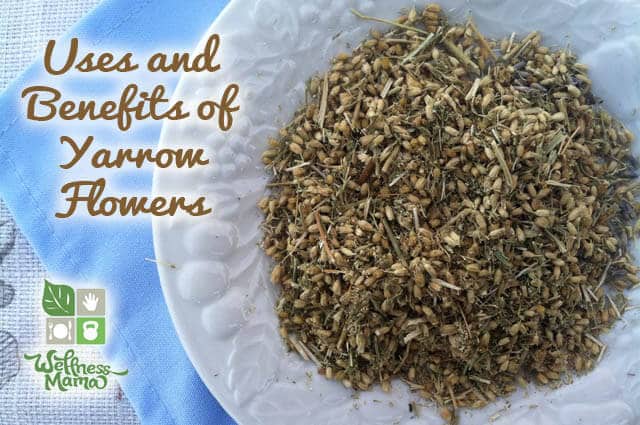Yarrow is an herb that I always keep on hand, especially with kids. It is part of my Sweet Dreams Sleep Tincture and I often add it to teas or preparations.
What is Yarrow?
According to Mountain Rose Herbs:
“It is a long-stemmed member of the sunflower family found in the wild throughout the temperate regions of the Northern Hemisphere. It can be recognized by its highly segmented leaves (millefolium literally means “thousand leaves”), and the clusters of daisy-like white or lavender flowers at the top of the stalk.
Greek myth had it that Achilles painted himself with a tincture of yarrow to make himself invulnerable to arrows, everywhere on his body except his heel. Native American herbal medicine makes extensive use of yarrow. Among the Micmac people of Maine, New Brunswick, and Nova Scotia, the stalk was chewed or stewed to induce sweating to “break” fevers and colds. They also pounded the stalks into a pulp to be applied to bruises, sprains, and swelling.
The Cherokee, Gosiute, Iroquois, and Mohegan peoples used it as a digestive aid. Other herbal healing traditions use yarrow to treat a variety of conditions characterized by swelling, often combined with echinacea, elder flower, ginger, and peppermint.”
Benefits of Yarrow:
Yarrow is one of my go-to herbs for children. It is helpful in relieving fevers, shortening the duration of cold and flu, helping improve relaxation during illness, and relieving cramps associated with hormones or illness. Applied topically, it is helpful with skin itching, rash or other issues.
An external tincture or poultice will often help with hemorrhoids, rashes and broken skin. Some people will notice relief from allergy symptoms by drinking a tea of yarrow and mint.
From Practical Herbalism:
“Yarrow flower used in chronic diseases of the urinary apparatus, is especially recommended by Prof. J. M. Scudder. It exerts a tonic influence upon the venous system, as well as upon mucous membranes. It has been efficacious in sore throat, hemoptysis, hematuria and other forms of hemorrhage where the bleeding is mall in amount; incontinence of urine, diabetes, hemorrhoids with bloody and mucoid discharges, and dysentery. Also in amenorrhea, flatulency and spasmodic diseases, and in the form of injection in leucorrhea with relaxed vaginal walls. It will be found to be one of our best agents for the relief of menorrhagia.”
Priest & Priest tell us that it is a mild, slow, and stimulating diaphoretic that is best used for the first stage of acute fevers, and for atonic and relaxed tissues where there is free discharge or passive hemorrhage of bright red blood. They recommend cold preparations to stimulate the appetite and tone the digestive organs, and give the following specific indications: Acute stage of colds; influenza and respiratory catarrhs; chronic diarrhea and dysentery; epistaxis; intestinal hemorrhage, bleeding hemorrhoids, uterine hemorrhage; profuse or protracted menstruation; and leucorrhea.”
From Mountain Rose Herbs:
“The British Herbal Compendium notes that preparations of yarrow lower fevers, induce sweating, stop cramps, encourage menstruation, relieve inflammation, and stimulate the release of stomach acid to digest proteins and fats. The herb is taken internally to treat colds, fevers, and indigestion, and used in skin treatments of slow-healing wounds. The Complete German Commission E Monographs recommends sitz baths with yarrow added to the bath water to relieve pelvic cramps in women.”
How We Use Yarrow:
- In homemade Buckwheat Relaxation pillows to help promote restful sleep
- In sweet dreams sleep tincture for times when falling asleep is difficult
- In teas (with mint and chamomile) during illness
- As a tea, tincture or poultice on skin for rashes and itching
- As a tincture to help ease menstrual cramps and hormone issues (not for use during pregnancy)
- Yarrow tea often helps with congestion symptoms from allergies and illness
- Adding yarrow to skin lotions, oils or salves can help with eczema or dry skin
- I add a strong yarrow tea to my child’s bath for a high fever that I want to bring down naturally
- Since it is helpful in stopping bleeding and avoiding infection, poultices of yarrow and plantain can be helpful on wounds
Where to Buy Yarrow
I buy Organic Yarrow Leaves and Flowers in bulk from here, as this is the most inexpensive way I’ve found and I just make my own teas, tinctures and poultices as needed. It can also be found in pre-made tinctures, teas, and lotions. For those who like to wildcraft herbs themselves, check with herbalists or experts in your area to see if Yarrow is a native plant.
Safety Notes
Not for use during pregnancy since it may stimulate the uterus, but I personally use in my post-labor tincture to help tone uterus, reduce cramping and avoid hemorrhage. Some people will develop a rash from touching the fresh plant. Should be avoided by those with allergies to ragweed. There are no studies proving safety in children so ask a doctor or herbalist before using.
Have you ever used yarrow? How do you use it? Share your tips below!




Leave a Reply